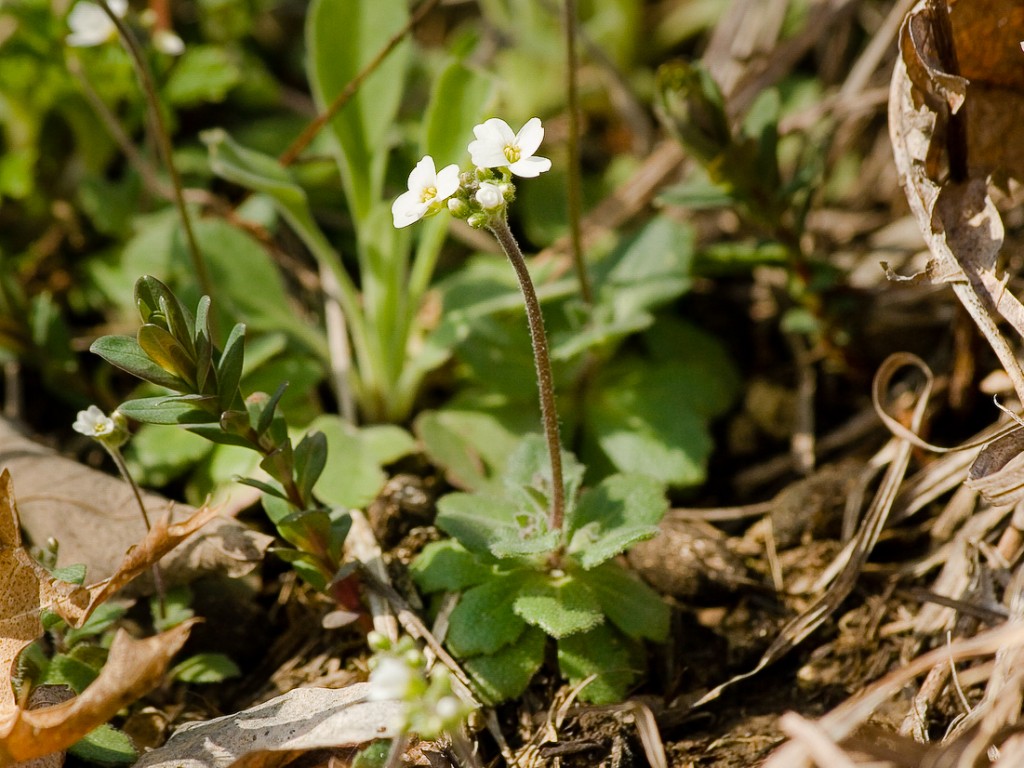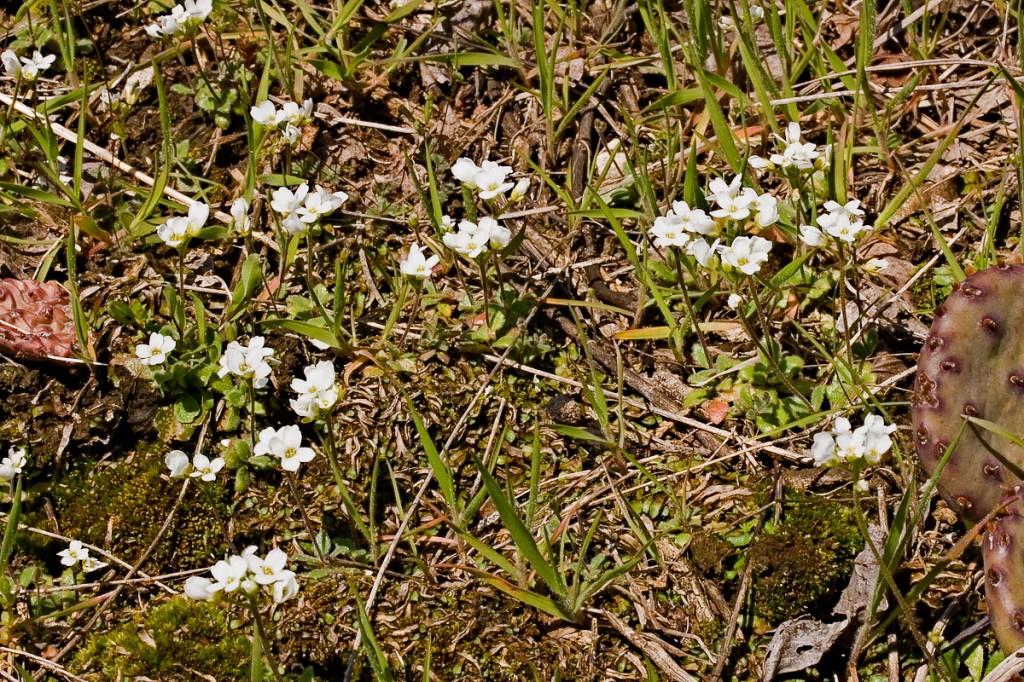Rare Plants in Xeric Limestone Prairies of the Illinois Ozarks
Article by Bill McClain; edited by Joann Fricke.

Whitlow grass (Draba cunifolia) grows in xeric limestone prairies -- oftentimes called "glades" -- in Monroe County. Photo courtesy Martin Kemper, Clifftop.
It was April 4, 2016, and Bill McClain, a former field biologist and Natural Areas Program Manager for the Illinois Department of Natural Resources and current commissioner with the Illinois Nature Preserves Commission, was on his way in his trusty old pickup to Fults Hill Prairie Nature Preserve in Monroe County to meet Marty Kemper, the former IDNR District Natural Heritage Biologist for this part of the state. Their objective was a visit to a xeric limestone prairie where they would look for early blooming plants. Bill and Marty had conducted a quantitative study of this community in the fall of 2015, so the purpose of this trip was to increase their knowledge of the site’s plant diversity.
You may be wondering what is meant by a xeric limestone prairie? Well, these communities are really old friends with a name change. They have been (and likely still are) known as limestone glades for as long as many of us can remember. They occur in many states throughout the eastern half of the nation, including, Alabama, Georgia, West Virginia, Pennsylvania, Ohio, Indiana, Illinois, Tennessee, Kentucky, and Missouri.
However, botanists at the University of Kentucky, Drs. Jerry Baskin, Carol Baskin, and Patrick Lawless, noted confusion caused by the application of the same name to two vastly different plant communities. These were what we know as limestone glades and the limestone glades (cedar glades) in the Central Basin of Kentucky and Tennessee. Our limestone glades or xeric limestone prairies are dry, sloping, and dominated by the warm season bunch grasses big and little bluestem and side-oats grama. In contrast, limestone glades in the Central Basin are flat, seasonally wet, and dominated by annual dropseed grass species. These distinct differences prompted them to develop a classification to distinguish the two communities and eliminate further confusion.
Xeric limestone prairies are present in Monroe County and a study was recently completed on two of them on the farm of Ralph and Karen Buettner. Xeric limestone prairies are also present within Fults Hill Prairie Nature Preserve. Marty and Bill wondered if they contained plants not present in the Buettner prairies. Further study would answer this question.

Martin Kemper and Bill McClain enjoying a brief pause in their botanical surveying of a xeric limestone prairie at Fults Hill Prairie Nature Preserve. Photo courtesy Martin Kemper.
Searching for small, annual, early-blooming plants was the prime reason for the pair’s April trip. Bill was focused on finding a tiny annual plant known as wedge-leaved Whitlow grass (it’s really a mustard). You may know that Monroe County is the only place of occurrence for this plant in the entire state, a bit of knowledge that gave the trip added importance.
Early blooming plants in prairie or grassland communities tend to be small, annual species that flower, produce seed, and often disappear within a few weeks following seed production. These traits and the rapid growth of other vegetation makes it difficult, if not impossible, to find these plants later in the growing season. Early visits and a discerning eye are essential in finding these plants.
Marty and Bill hiked up the hill to the study site. There they were delighted to find over 100 individuals of the wedge-leaved Whitlow grass growing in the xeric limestone prairie. Mohlenbrock’s Vascular Flora of Illinois lists limestone ledges as its habitat, but we can also list it as a bonafide member of xeric limestone prairies. This discovery is significant locally, but potentially nationally significant as we continue to learn more about these communities.
Bill and Marty’s discovery needed to be tested. If wedge-leaved Whitlow grass is a member of xeric limestone prairies, then it should be present in the Buettner prairies a mile or more east of Fults. They drove there and found the plant in both prairies in a matter of minutes. It was such an exciting moment for both men. This plant was not found previously in the Buettner prairies because it was assumed no plants would be blooming in early April. This experience told the scientists that geology is not the primary influence determining the distribution of this plant. Habitat is the primary factor because its largest, most robust populations are in xeric limestone prairies. Perhaps visits by other botanists have been too late to find it in the xeric limestone prairies.

Given favorable conditions, whitlow grass can grow in profusion. These lovely flowers often grow near prickly pear cactus (Opuntia humifusa), another species that can flourish in the dry, thin-soils of a xeric limestone glade. Photo courtesy Martin Kemper, Clifftop.
McClain and Kemper have since noticed other rare plant species in the Fults prairie. The botanical texts describe all of these as “edge” species, meaning they grow only on cliff margins. They have found them in profusion (if a rare plant can do that) in xeric limestone prairies. Now each trip has the two wondering if they will find another rare plant. Unfortunately, the recent hot, dry period greatly affected plant growth, but it is a xeric (very dry) limestone prairie and their study is short term, like Bill’s frustration regarding shriveled plants. The plants have been here for millennia, waiting for someone to find them.
What are these other plants and how do the Monroe County prairies compare to those in other states? Well, Marty and Bill are presenting a program about their study, so you will learn the rest of the story at that time. Their study proves we are still learning about the biodiversity of the Illinois Ozarks after nearly two centuries of botanical exploration. Being at the right place at the right time is critical to making new discoveries. That next rare plant may be just over the hill (better the plant than us).
Please join us for a seminar on “Rare Plants in Xeric Limestone Prairies” on March 11, 2017, from 1:00 until 3:00 p.m. at the Monroe County Annex, 901 Illinois Avenue, Waterloo. The presentation will be made by Bill McClain and Martin Kemper and the program is free and open to the public. Registrations are required by March 9th and may be made by email to cliffmbr@htc.net or by calling 618-935-2542.
CLIFFTOP, a local nonprofit organization, is focused on preserving and protecting area bluff lands.
A version of this article appeared in the 3 March 2017 edition of the Monroe County Independent.
© 2017 all content rights reserved Clifftop NFP
Comments are currently closed.
